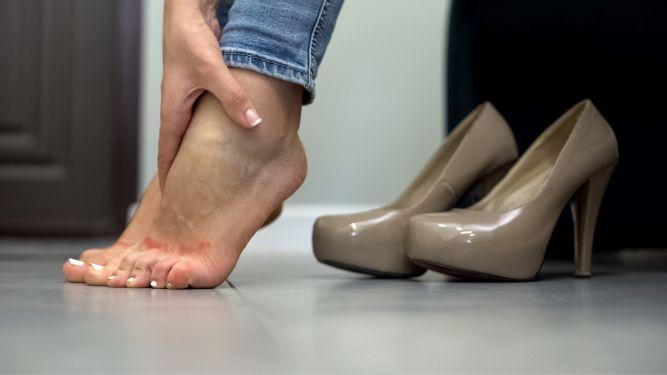Are My Shoes Giving Me Bunions?
posted: Jul. 19, 2022.

At some point, everyone seems to ask themselves, “Are my shoes going to give me bunions?” If you’ve never asked yourself this question, then maybe it’s about time you did. Your footwear plays a pivotal role in your overall foot health. Not many people think twice about the type of shoes they purchase. This can lead to severe ramifications down the road.
If you like to go jogging, participate in high-impact sports, or simply rely on your feet to carry you through your daily life, you’ll want to start wearing proper shoes and avoid the pains of bunions.
What Is a Bunion?
A bunion is a painful deformity that affects the joint located at the base of the big toe. When bunions develop, they impact the metatarsophalangeal joint (MTP joint) and the phalanx of the foot. A bunion is shaped like a bony bump and can grow. As it grows, it can add pressure on the big toe, as well as the rest of your toes. This can make walking, running, and standing a pain-inducing task.
What Causes Bunions?
There can be a genetic component involved in the development of bunions on your feet, but they primarily occur because of poor foot structure and wearing tight-fitting shoes. Many people will experience bunions that get worse over time.
Most bunions become aggravated by the following:
Shoes: Those who wear shoes that are too tight, too narrow, or too pointed are most likely to develop bunions.
High Heels: If you wear high heels, your toes will get little room and be forced together. The pressure can lead to the formation of a bunion.
Rheumatoid Arthritis: Having an inflammatory condition like arthritis can increase your chances of getting bunions.
Symptoms of Bunions
You may notice specific symptoms involved in the formation of bunions, such as:
A bump that bulges outside of the base of your big toe
Swelling, redness, or soreness around the area of the bunion
The development of corns or calluses around the first and second toes when they rub together
Limited range of movement in your toes
Does Shoe Size & Design Really Matter?
There is much debate over whether wearing certain types of shoes leads to bunion formation. It would appear that the risk factors involved with bunions stem from familial genetics and shoe choice. A bunion can form easier if you already have a specific foot structure, such as flat arches.
As we mentioned, genetics can also play a deciding role in whether you develop bunions. If someone in your family has had a bunion, the chances of experiencing the same fate will be higher.
While there is still much debate over whether tight shoes and high heels cause bunions, they still play a role in aggravating/worsening the condition. Making good shoe choices is always beneficial. Choosing the wrong footwear can trigger or hasten the development of a bunion. Imagine having to cram your feet into a narrow-fitting shoe and walking around in it all day. Fashion choice aside, it can be an uncomfortable situation.
Making Better Shoe Choices
It’s never a bad idea to make better choices for your footwear. You need shoes that are comfortable with a roomy toe and provide support. To find the best pair of shoes, you need to call attention to specific factors:
A Proper Fit: Many people have sacrificed comfort for style, even if the shoe doesn’t fit properly. How many times have you heard of “breaking in” a new pair of shoes? The answer is too many times to count. Shoes should fit nicely and comfortably. That’s why it’s essential to have your feet properly sized to ensure you make the right choice.
Enough Toe Room: If you wear shoes with a restrictive or narrow toe box, you’ll aggravate or increase the risk of bunions. When trying on new shoes, make sure you have ample room for your toes to lay in a natural position. Test out the space by wiggling your toes to see if you can do it comfortably in a wide toe box.
Arch Support: Shoes that offer solid arch support will benefit you in the long run, such as a shoe with a slightly elevated heel. It can also decrease the amount of pressure on the TMJ joint, which means less discomfort while walking.
Orthotics: Having your own custom orthotics or shoe inserts can help with an abnormal foot structure or gait pattern. It can relieve the amount of pressure you put on your MTP joint. Our team of chiropodists can craft custom orthotics and shape them to fit the style of shoe you wear.
It’s best to avoid shoes that shift weight toward the front of your feet and press on your big toe joint. If you absolutely need to wear a pair of heels for a special occasion or for the workplace, there are some ways you can minimize the risk of bunions. Wear these types of shoes occasionally and resist heels that are higher than ~5 cm (2 inches).
Platforms or heels with thicker wedges will do a better job of supporting your weight and absorbing the shock of impact when walking.
What if I Already Have Bunions?
Making the switch to comfortable footwear when you already have a bunion can prevent it from worsening. It can also decrease the pain when walking, standing, or running, as you’d have more cushion.
There are numerous treatment options to take care of your bunions, such as nonsteroidal anti-inflammatory drugs (NSAIDs), steroid injections, physical therapy, orthotic devices, or surgery.
Academy Foot & Orthotic Clinics can provide the best Toronto foot specialist to ensure you get the services you deserve. Living with bunions or any other painful foot conditions can be a debilitating experience. The good news is you don’t have to live with that pain forever. Contact us today!